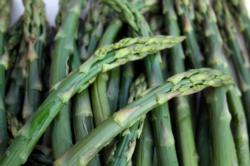
|
|
Asparagus takes years. (Photo courtesy UCANR)
|
It takes time to grow this perennial vegetable
Asparagus takes patience; it’s a commitment, not a zucchini.
One of the few perennial vegetables, asparagus will produce 15, 20 years or more from one planting. What it needs most is time and space. (Compost helps, too.)
When I lived in Southern California, I grew asparagus for decades. In February and March, it was like a daily Easter egg hunt in the asparagus bed, only the prize was a finger of asparagus, not a colorful egg. The rest of the year, the asparagus formed a big ferny backdrop to the vegetable and flower garden. Often as tall as the fence, the delicate fronds were studded with bright orange-red berries, which produced baby asparagus sprouts all over the place.
In the Sacramento area, the availability of fresh Stockton asparagus dissuaded me from growing my own. Now, supermarkets are flooded year-round with cheap Latin American imported stalks, which suffer from their intercontinental trek. And real local asparagus is becoming harder to find. Labor intensive at harvest, asparagus is being replaced by other crops in the Central Valley; since 2000, about three-quarters of California’s asparagus acreage has disappeared.
That’s brought me back to taking another look at asparagus.
Asparagus takes a while to get started; sort of like planting a fruit tree, there’s no harvest right away. But as the roots build energy and size, asparagus crowns start multiplying the number of shoots each can produce. They may even push up a few fall spears.
What to plant? Martha Washington is the old standard and what I grew in the past. It has both female and male plants; the females produce scads of red berries and seeds, which can become a weedy nuisance. Developed at Rutgers University, all-male asparagus hybrids reportedly are three times more productive than open-pollinated varieties such as Martha Washington. They have no seeds, concentrating all their energy on roots and spears. These hybrids all have “Jersey” in their names such as Jersey Knight, Jersey Giant and Jersey Supreme.
How many to plant? At least a dozen crowns for two people; it takes a lot of asparagus plants make a bunch of spears.
Seed or crowns? Rootstock, now available in local nurseries as well as online, is usually three years old; that’s a big head start over planting asparagus seed. Planted now, those crowns will produce their first (very skinny) edible spears in spring or fall 2020. In 2021, they’ll start pushing up spears that look like acceptable asparagus, but only three to five per plant can be harvested. Other spears need to be allowed to leaf out in order to feed the plant. In 2022, the crowns start to become more generous and consistent, a trend that keeps building for several years to come.
Besides a multi-year wait, asparagus also requires room and a visible location (at least to the gardener). Spaced 16 inches apart, a dozen crowns need the same room as a twin mattress; it really is an asparagus bed. If the crowns are too crowded, they’ll never produce fat spears.
Asparagus prefers full sun, but unlike most veggies, will tolerate partial shade. A spot that gets morning sun works well. Choose a place on the north or east end of the garden, so the tall summer fronds won’t shade other plants.
Once they reach maturity, asparagus can push up multiple spears a day. They can grow 6 to 9 inches in an afternoon; you can almost watch them get taller. If left a couple of days, those tasty spears become inedible fronds. Plant them in a spot where you can easily see them every day.
Don’t plant them at the back of the perennial flower bed where you can’t see them sprout; you’ll end up with a wall of fern and no spears. (I know.)
Asparagus also demands good drainage; it can’t stand wet feet. That makes it a good candidate for a raised bed (or mounds).
An asparagus crown looks like an octopus with a dozen long legs. Before planting, soak the crowns and roots in water for an hour to rehydrate.
Traditionally, asparagus is planted in deep trenches, half filled with well-rotted manure or compost. Instead, make a planting hole about 8 inches deep and wide. Mix the soil from the hole with compost. Sprinkle 2 tablespoons bone meal into the hole. Form a 6-inch mound in the center and place the crown on top of that mound, spreading the roots in all directions into the hole. Fill the hole with soil and compost mix, covering the crown with about 2 to 3 inches of soil. Water, then wait.
Like other perennials trying to get established, asparagus needs consistent irrigation its first year. That’s 24 to 30 inches annually, translating to about a half inch per week (or half the water needed for turf grass). Asparagus becomes more drought tolerant with age.
After planting, asparagus doesn’t need much feeding. Avoid nitrogen-rich fertilizers; they produce too much fern. Instead, sprinkle a little bone meal over the bed in mid-summer to give the roots a boost.
To cut down on weeds as well as retain moisture, cover the asparagus bed with straw or other mulch, but not too thick; you’ll miss those sprouts.
The ferns brown and die back in late fall. Cut them to the ground each winter; that’s really the only annual maintenance asparagus needs and cues the roots to start sending up fresh spears. Just remember: Be patient.
For more information on growing asparagus in Northern California, check out these links from the UC Cooperative Extension master gardeners:
http://ipm.ucanr.edu/PMG/GARDEN/VEGES/asparagus.html
and
https://bit.ly/2ssSl1Y

